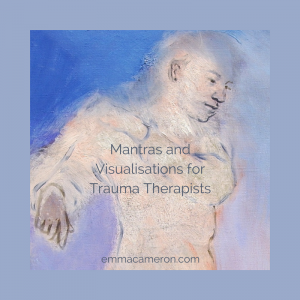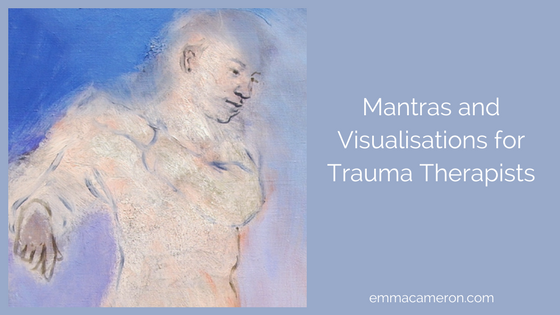Mantras and Visualisations for Trauma Therapists
Here, in this follow-up to my previous post, How Do Therapists And Counsellors Protect Themselves From Getting Traumatised?, I’d like to share some mantras and visualisations for trauma therapists that are used by counsellors, psychotherapists and Arts Therapists in their day-to-day working lives.
Supportive self-talk and related practices play a part in helping us not become incapacitated and caught up in our clients’ trauma fields.
Mantras and visualisations for trauma therapists. #counselling #therapy #arttherapy Share on XI don’t take credit myself, for these mantras and visualisations for trauma therapists were supportively offered in an online group for therapists. I’m sharing them here with the generous permission of the contributors. (Most preferred to remain anonymous, but some are credited – you’ll find their names below).
Mantras
Mantras are things you can say to yourself, either sub-vocally or out loud, depending on the situation. Sometimes mantras are most effective when repeated over and over, according to what you feel you need.
Single-Word Mantras
You might repeat single words to yourself, perhaps combining this with bilateral tapping or gentle patting on your chest or thighs.
- ‘Love’
- ‘Patience’
- ‘Calm’
- ‘Serenity’
- ‘Peace’
- ‘Whole’
What’s Mine; What’s Theirs
Simple statements can remind you that even though your heart goes out to your clients, and you may care deeply for them, you and they are separate and you don’t have to hold their trauma as your own. Here’s what some therapists tell themselves:
- ‘Their story is not your story.’
- ‘This does not belong to me.’
- ‘This is not my pain.’
Faith in the Existence of Good
“I am always comforted by realizing that there are still so many helpers – so many caring people in this world” said much-loved US TV presenter Mr Rogers. Holding an awareness of ‘good’ can be immensely helpful, especially when you are confronted with so much evidence that very bad things do happen. Mantras help many therapists hold on to an awareness that goodness, healing and growth are real:
- ‘There is good in this world.’
- ‘Healing is possible.’
- “All shall be well, and all shall be well, and all manner of thing shall be well” (Julian of Norwich, 1342-1416)
- ‘I remember that it’s not all down to me. There are other good people and supportive forces in the world.’
- ‘I am part of an enormous circle of helpers all around the world.’
- ‘I surrender [name of client] to their path of highest good.’
Positive Reframing
When we encounter a lot of trauma it can be helpful to remind ourselves that within something very dark can also lie the seeds of transformation and growth:
- ‘The wound is where the light enters.’
- ‘No one is shooting at me today.’ (From a therapist who is an army veteran)
- ‘I try to focus on the strength and resilience of the client in front of me. That leaves me feeling hopeful (typically) versus filled with doom.’
- ‘I remember that the caterpillar turns to mush during its process of transitioning into a butterfly. This helps me sit with my clients in their dark places and honour where they are now, knowing that sometimes it can be a necessary part of their journey to a more ‘whole’ place.’
- ‘I think about kintsugi, the Japanese tradition of mending cracked pottery with gold, to create something that is even more beautiful because of having been broken and re-set.’
Gratitude
Along with awe, joy, vitality, pride, and feeling moved, gratitude is a ‘healing affect’, according to Diana Fosha PhD, author of The Transforming Power of Affect and founder of AEDP. We can boost our own resilience by consciously making space for acknowledging and feeling gratitude, as these therapists do:
- ‘I think of it as a privilege that I get to be present for the freedom of release of these often decades-long secrets.’
- ‘How beautiful is my profession that someone can trust me with their traumas?!’
- ‘In session I remind myself how blessed I am to be a conduit for hope and healing.’
You Are Enough
Despite years of training, therapists sometimes feel very inadequate when we are trying to help people who may have suffered very traumatic experiences or longstanding relational disruptions. These mantras address that:
- ‘You are the helper, not the healer.’
- ‘It’s their journey not my journey, and I’m here to listen.’
- ‘When I am truly present with someone, I am enough.’
- ‘I don’t have to fight China (like the Dalai Lama).’
- ‘I remind myself of Brene Brown’s maxim, ‘Don’t shrink, don’t puff up, stay on your sacred ground’. It helps me in all sorts of situations, including when I start to feel insufficient with a traumatised client.’
- ‘I am making a difference’
- ‘I am here to witness not rescue.’
Self-Compassion
Acknowledging and holding pain with not just compassion for your client but also tender self-compassion, can be very powerful.
- ‘I touch my hand gently to my cheek, and say ‘May I be at ease. May I accept myself. May I know deep peace. May I be kind to myself’. I think it’s called Metta meditation.’
- ‘Kristin Neff has some good stuff on self-compassion on her website, and I use that to support myself. I particularly like to say to myself, ‘This is a moment of suffering, and anyone would find this hard’.’
Chanting
Chanting allows this therapist to move into a different emotional space:
- ‘I like the yoga chant Sa Ta Na Ma. I was taught to do it while touching my fingers to my thumb at each syllable (both sides at the same time) starting with index fingers at Sa and moving through to the pinkie.’
Visualisations
Neuroscience studies have shown that creative visualisations can have a measurable effect on the nervous system of body and brain. Many counsellors and psychotherapists use visualisations to help themselves release trauma and stress, and bring themselves back into a state of emotional equilibrium and resilience. Here are some visualisations that therapists use:
Releasing and Taking Back
This theme can be creatively adapted in all sorts of ways. Here’s how some therapists do that:
- ‘I often visualize releasing whatever I’ve held from the client, and taking back whatever of my self that I’ve given to the client, with the intention of compassion and trust in their strengths and resources.’
- ‘I am a vessel of light and love to ease pain and suffering… my cup overflows with light (visuals that remind me that I am NOT a container or vessel for the pain or trauma). Take a moment to ground and release (visualize it all running through the soles of your feet into the ground).’
- ‘I use a process called “cord cutting”. It is an energy healing technique in which I visualize having the ability to detach from any ‘cords’ that might keep me connected to said client. I use this practice daily and in all areas of my life.’
- ‘After each client goes out the door, I visualise them surrounded by a protective colour and I say ‘May you go in peace and may you be released from suffering’. Then I do the same for myself, with a different colour.’
- ‘I like Tonglen practices (from Buddhism). I visualise myself breathing in the other person’s suffering and breathing out loving-kindness towards them. I do find it beneficial for myself, even though I’m taking in the other person’s difficult stuff.’
Passing Through
One therapist shared their metaphor of a screen door:
- ‘I imagine I am a screen door when listening to the story…so I am present and available, and the story doesn’t ‘stick’ but passes through like a soft breeze.’
Transformer
The transformer, or converter, is a metaphor that some therapists find very powerful:
- ‘I think of my body as a converter. I breathe in coal, breathe out diamonds. Breathe in sickness, breathe out health. Breathe in trauma, breathe out peace.’
- ‘I use the imagery of a diamond, letting energy/light move through, remaining hard and smooth, refracting the pain into something beautiful. Somehow, this enables me to fully listen with compassion, and keeps me from crying.’
Comfort
When we have been deeply touched by a client’s pain, we can offer ourselves some comfort:
- ‘Sometimes when stressed I visualize my bed and my jammies!’
- ‘I visualise a warm, gently weighted cushion over my heart area. Sometimes I’ll put my hand there too, and invite my client to do the same for himself.’
- ‘I like the ‘butterfly hug’, where I hug myself whilst tapping on alternate shoulders.’
- ‘I visualise something that makes me feel warm and happy. I try and involve all my senses in the visualisation.’
Practices
I have written elsewhere (see below) about other practices that therapists use to help themselves keep grounded and supported, both in and after sessions.
Here are a few ideas from therapists that might inspire and work for you:
Sounds
You might use sound and vibration as a focal point for meditation and mindfulness. Some therapists also like to involve aural bilateral stimulation:
- ‘I put on the Mark Grant EMDR cd’s and listen to the audio tones until my distress is down or gone. He has some tracks on the Anxiety Release album that are guided too. Very effective.’
- ‘On the Insight Timer app there’s slow bilateral tones with music that I listen to, to calm and focus me.’
- ‘I have a singing bowl. Works like magic!’
Water
Water is an essential element in our lives, so it’s not surprising that many therapists include water in self-care rituals:
- ‘Fill some water in a bowl before the session , then empty all of the pain and negativity afterwards.’
- ‘At the end of the day, I shower and wash all the hurt away in a renewal process. I imagine that when washing my hands as well.’
- ‘I get in a warm shower and let all the pain go down the drain. Wonderful imagery that works for me.’
Forgiveness
One therapist uses the Hawaiian forgiveness practice of Ho’oponopono after challenging sessions:
- ‘I do Ho’oponopono with the feelings it brings up within me. Sooo helps to detach.’
Bringing in the Senses
- ‘I wash my hands with scented soap, brush my teeth and think about a breezy Fall day among autumn colored trees.’
- ‘Essential oils help me.’
Breathing
- ‘I meditate before each client and, as a practice, always ground during session. When a particularly difficult story is shared I pay attention to my body for countertransference and remind myself that this is “Not your story”. I explore the countertransference with my supervisor.’
- ‘One of the things I’ve found is that if I’m starting to feel heavy during a session, usually my client is, too. So sometimes I ask if they want to pause and we do a relaxation/breathing exercise called “setting down the world”. I frame it in context for them but it’s really for me. It works so so well. And….there’s always something to be said for singing in the car!’
- ‘I also find remembering to breathe, breathe, and breathe. As I am witnessing someone’s story and pain I also remind myself that by being present with this person, I am a representation of light and an opposing energy to what they experienced. But it is hard to remember that in the hard stuff…sometimes I just get exhausted.’
- ‘After a session I practise a few rounds of the 4-7-8 breath.’
Pets
- ‘I work with my dog so I connect with his warm, furry, unconditionally loving self and pull in a whole bunch of positive warm fuzzies.’
- ‘I work from a home office. Stroking and connecting with my cat after sessions helps me recenter myself and release traumatic energies.’
Sleep
- ‘I take a nap at lunchtime. (That’s what the therapist’s couch is really for, right?!)’
- ‘Before I did body based work, I would often sleep at the end of the day because I felt depleted. Looking back, I think that wasn’t the best response for my self care. I think it was a way to avoid a lot of distress I was carrying in my body. Sometimes I would feel groggy when I woke up, and it affected my ability to get to sleep at night. There are times though, where I feel intense sleepiness after a tough session, and I need to sleep. It’s like falling off a cliff. I sleep hard, and I awake refreshed, so I know that kind of sleep is what my body needs sometimes. I’ve also noticed different needs at different ages, I needed to “sleep off” the day’s stress much more in my younger years. It’s fascinating to me, how my body has such wisdom to heal itself if I can just tune in and heed it.’
Prayer and Meditation
- ‘I pray before each work day.’
- ‘I sit and focus on the sensations in my body. I track them as they shift in intensity and move within me. When I pay attention to my body, inevitably I become aware of areas that are reacting, and as I focus on these sensations they do their thing and then they subside. This helps me release whatever traumatic energy I absorbed during the session. I also regularly do this when I am falling asleep at night to keep myself balanced.’
- ‘I use Reiki, meditation, poetry, painting, and essential oils.’
- ‘I do an energetic/spiritual “tune-up” each working day, asking for the best possible help in working with [name each client], and a brief re-tune-up before each client, including their name. And I give thanks, give each client by name to the care of spirit/universe, & “tune-down” at the end of the work day. We all need to figure out what works for us & serves our clients best.’
Movement
Movement is well known to be an important aspect of processing trauma.
- ‘I really have to move my body between sessions. Stretches and jumping-jacks work for me, and help me release some of the trauma residue that’s been held in my body.’
- ‘I like to swing my arms around, all floppy, twisting my body from side to side.’
Spine Visualisation
The spine is not just a metaphor for self-support – it is, of course, concretely there. This therapist combines imagery, movement and body awareness to help them feel supported and strong:
- ‘When I’m feeling wobbly and very affected after a session by my client’s trauma, I sit or stand tall and move my attention to my spine. I visualise it and think about how strong it is, how flexible and supportive. I sense how it needs to move or stretch. That’s usually enough to keep me feeling steady and supported.’
Perspective-taking
Several of the therapists quoted above agreed on the importance of taking a particular perspective on the work they do with their clients.
One Art Therapist explained:
- ‘Not so much a mantra as it is a perspective. I feel that my clients need to release their trauma in order to heal, and I hold that safe space for them. They are reminded of that and the fact that they are safe in the moment while remembering the memories. I think externalizing the trauma for them also helps keep it in perspective for me as well. It also helps when the trauma is expressed through art and is really separated from us. I’m always reminding my clients that once they process something to their satisfaction they can metaphorically “throw it away in the trash can” and sometimes the art ends up there too!’
Purpose, Meaning and Values
Connecting to your sense of higher purpose and meaning can be very supportive. As Nietzsche wrote ‘He who has a why to live for can bear almost any how’. One therapist explained:
- ‘I keep reminding myself of why I do this work, and how it fits with my deep values and what I see as my purpose in life. I find this really helps me.’
Acceptance and Commitment Therapy (ACT), which I hold in high regard, places great emphasis on the importance for self-care of continuing to hold one’s values in mind.
Sayings, mantras and visualisations that trauma therapists use for self-support. Share on XWhat Other Mantras and Visualisations for Trauma Therapists Do You Find Helpful?
Counsellors, psychotherapists and Arts Therapists often work with people who have suffered trauma. To continue to be present and available to help our clients, and not get burned-out by the challenging nature of trauma work, it’s really important that we find effective, meaningful ways to support ourselves.
Do you have a favourite mantra, quote, visualisation, ritual etc, that helps you to keep yourself grounded and supported as you do trauma work with your clients? Please share it in the comments below!
You can also read more about other aspects of self-care for therapists here:
How Do Therapists Protect Themselves From Getting Traumatised?
Floating Your Boat: Self-Care for Therapists and Counsellors
Looking After Yourself in the Therapy Room
6 Essential Self-Care Books for Therapists
7 Hidden Self-Care Ideas That Therapists Can Sneak into Their Day
I would like to extend my sincere thanks to all the counsellors and therapists who have contributed their mantras and visualisations for trauma therapists. I would particularly like to mention Renee Beck, LMFT in Oakland, CA; Mark Rosenthal, LCSW in Louisville, KY; Modena Jenkins, LMSW in Wichita, KS; and JoAnne Hanson, LMFT in Philadelphia, PA.
For more about up-to-date approaches to treating trauma, you may like to read my article ‘Trauma Therapy Has Changed – Here’s How’.




